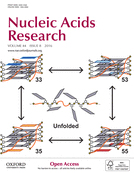- EN - English
- CN - 中文
Knock-in Blunt Ligation Utilizing CRISPR/Cas9
利用CRISPR/Cas9敲入平端连接
发布: 2017年03月05日第7卷第5期 DOI: 10.21769/BioProtoc.2163 浏览次数: 10263
评审: Renate WeizbauerAnnis Elizabeth RichardsonPriyanka Das

相关实验方案

利用Topo与限制性系统将基因克隆至转座子载体的简便可适应方法及其在鸡胚转基因中的应用
Pamela Kirimi [...] Yatinder Binepal
2025年08月20日 1011 阅读
Abstract
The incorporation of the CRISPR/Cas9 bacterial immune system into the genetic engineering toolbox has led to the development of several new methods for genome manipulation (Auer et al., 2014; Byrne et al., 2015). We took advantage of the ability of Cas9 to generate blunt-ended double-strand breaks (Jinek et al., 2012) to introduce exogenous DNA in a highly precise manner through the exploitation of non-homologous end-joining DNA repair machinery (Geisinger et al., 2016). This protocol has been successfully applied to traditional immortalized cell lines and human induced pluripotent stem cells. Here we present a generalized protocol for knock-in blunt ligation, using HEK293 cells as an example.
Keywords: CRISPR/Cas9 (CRISPR/Cas9)Background
At the time we conceptualized knock-in blunt ligation (Geisinger et al., 2016), the vast majority of methods developed for use with CRISPR/Cas9 were focused on enhancing the efficiency of homologous recombination. However, there was one exception: a homology-independent, plasmid-based knock-in method developed in zebrafish (Auer et al., 2014). This method, like knock-in blunt ligation, relies on the machinery of canonical non-homologous end-joining to insert a linearized, blunt-ended, double-stranded DNA fragment into a genomic double-strand break with a high degree of precision and minimal loss of nucleotides. Both methods are similar to a method developed for zinc-finger nucleases and TALENs known as obligate ligation-gated recombination (ObLiGaRe; Maresca et al., 2013), which relied on the generation of compatible overhangs to facilitate insertion of target DNA into the genome. Both the Auer method and ObLiGaRe rely on delivery of a vector bearing the desired transgene construct, which could lead to incorporation of undesirable exogenous sequences. Because of the propensity of Staphylococcus pyogenes Cas9 to make blunt-ended double-strand breaks, we reasoned that exogenous sequence delivery in genome engineering experiments could be limited to solely the CRISPR/Cas9 expression vector and a PCR-generated amplicon of solely the sequence of interest. Thus, knock-in blunt cloning possesses the dual advantages of minimizing the introduction of exogenous sequences and its reliance on canonical non-homologous end-joining rather than homologous recombination. While the following protocol is specifically for human HEK293 cells, we note that this method is likely to be broadly applicable to eukaryotic cells.
Materials and Reagents
- ChromaSpin+TE-1,000 chromatography columns (Takara Bio, Clontech, catalog number: 636079 )
- Falcon® polystyrene 24-well tissue culture microplates (Corning, Falcon®, catalog number: 353226 )
- Thin-walled PCR tubes (Thermo Fisher Scientific, Thermo ScientificTM, catalog number: AB1182 )
- Falcon® test tube with cell strainer snap cap (Corning, Falcon®, catalog number: 352235 )
- Falcon® polystyrene 96-well tissue culture microplates, flat bottom (Corning, Falcon®, catalog number: 353916 )
- 1.75 ml microcentrifuge tubes
Note: Manufacturer does not matter. - Optional: 10-cm tissue culture dishes (Corning, catalog number: 353003 )
- A human cell line, such as HEK293
- Avector that expresses the guide RNA or RNAs of interest and Cas9 (e.g., Addgene, catalog number: 42230 )
- Double-stranded DNA template, preferably plasmid
- DNA oligos containing three phosphorothioate bonds at the 5’ end of each oligo for PCR amplification of a template
- A high-fidelity, blunt-end generating DNA polymerase: Phusion (New England Biolabs, catalog number: E0553S ) or Q5 (New England Biolabs, catalog number: M0491S ), with associated buffer, are the only acceptable polymerases for this protocol
- 10 mM dNTPs (New England Biolabs, catalog number: N0446S )
- MinElute PCR Purification Kit (QIAGEN, catalog number: 28004 )
- FastDigest DpnI (Thermo Fisher Scientific, Thermo ScientificTM, catalog number: FD1703 )
- Nuclease-free water
- A transfection reagent such as FuGENE® HD (Promega, catalog number: E2311 )
- Opti-MEM I media (Thermo Fisher Scientific, GibcoTM, catalog number: 31985062 )
- NucBlue® Fixed Cell Stain ReadyProbes® reagent (Thermo Fisher Scientific, Molecular ProbesTM, catalog number: R37606 )
- Phosphate buffered saline (PBS)
- 0.05% trypsin-EDTA (Thermo Fisher Scientific, GibcoTM, catalog number: 25300054 )
- DMEM, high glucose (Thermo Fisher Scientific, GibcoTM, catalog number: 11965092 )
- Fetal bovine serum (FBS)
- 0.5 M EDTA, pH 8.0 (Thermo Fisher Scientific, InvitrogenTM, catalog number: 15575020 )
- Growth media (see Recipes)
- FACS media (see Recipes)
Equipment
- PCR thermocycler (Bio-Rad Laboratories, catalog number: 1861096 )
- Tissue culture hood, Type B2 biological safety cabinet (e.g., Thermo Fisher Scientific, Thermo ScientificTM, model: 1300 Series Class II )
- Incubator (37 °C and 5% CO2) (e.g., Thermo Fisher Scientific, Thermo ScientificTM, model: Series 8000 )
- Microcentrifuge (e.g., Eppendorf, model: 5424 )
- FACSAria II cell sorter (BD)
- Hemocytometer (Neubauer chamber) or equivalent method
Procedure
文章信息
版权信息
© 2017 The Authors; exclusive licensee Bio-protocol LLC.
如何引用
Geisinger, J. M. and Calos, M. P. (2017). Knock-in Blunt Ligation Utilizing CRISPR/Cas9. Bio-protocol 7(5): e2163. DOI: 10.21769/BioProtoc.2163.
分类
植物科学 > 植物分子生物学 > DNA
分子生物学 > DNA > 诱/突变
分子生物学 > DNA > DNA 克隆
您对这篇实验方法有问题吗?
在此处发布您的问题,我们将邀请本文作者来回答。同时,我们会将您的问题发布到Bio-protocol Exchange,以便寻求社区成员的帮助。
提问指南
+ 问题描述
写下详细的问题描述,包括所有有助于他人回答您问题的信息(例如实验过程、条件和相关图像等)。
Share
Bluesky
X
Copy link











